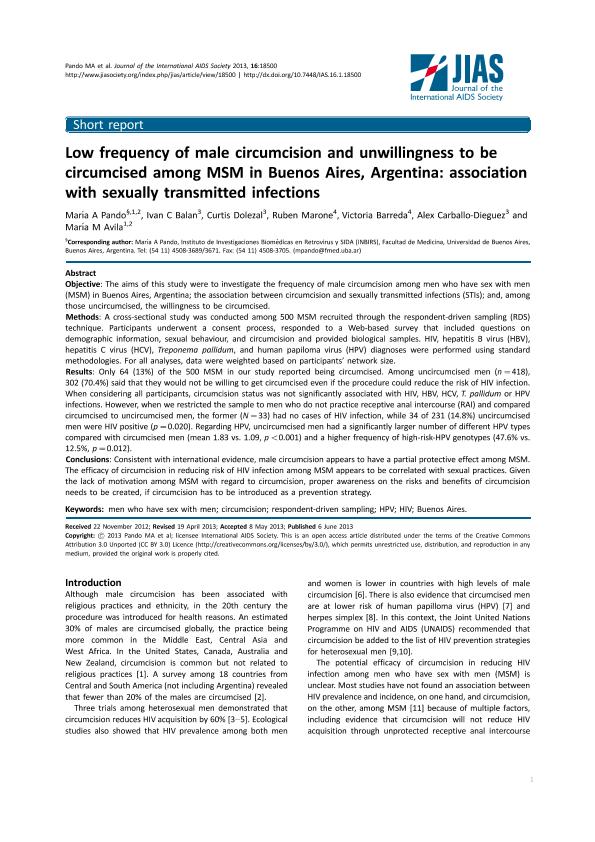Mostrar el registro sencillo del ítem
dc.contributor.author
Pando, María de los Ángeles

dc.contributor.author
Balan I
dc.contributor.author
Dolezal C
dc.contributor.author
Marone R
dc.contributor.author
Barreda V
dc.contributor.author
Carballo Dieguez A
dc.contributor.author
Ávila, María Mercedes

dc.date.available
2017-07-26T20:54:30Z
dc.date.issued
2013-06
dc.identifier.citation
Pando, María de los Ángeles; Balan I; Dolezal C; Marone R; Barreda V; et al.; Low frequency of male circumcision and unwillingness to be circumcised among MSM in Buenos Aires, Argentina: association with sexually transmitted infections; International AIDS Society; Journal of the International AIDS Society; 16; 6-2013; 18500-18501
dc.identifier.issn
1758-2652
dc.identifier.uri
http://hdl.handle.net/11336/21394
dc.description.abstract
Objective: The aims of this study were to investigate the frequency of male circumcision among men who have sex with men (MSM) in Buenos Aires, Argentina; the association between circumcision and sexually transmitted infections (STIs); and, among those uncircumcised, the willingness to be circumcised. Methods: A cross-sectional study was conducted among 500 MSM recruited through the respondent-driven sampling (RDS) technique. Participants underwent a consent process, responded to a Web-based survey that included questions on demographic information, sexual behaviour, and circumcision and provided biological samples. HIV, hepatitis B virus (HBV), hepatitis C virus (HCV), Treponema pallidum, and human papiloma virus (HPV) diagnoses were performed using standard methodologies. For all analyses, data were weighted based on participants’ network size. Results: Only 64 (13%) of the 500 MSM in our study reported being circumcised. Among uncircumcised men (n=418), 302 (70.4%) said that they would not be willing to get circumcised even if the procedure could reduce the risk of HIV infection. When considering all participants, circumcision status was not significantly associated with HIV, HBV, HCV, T. pallidum or HPV infections. However, when we restricted the sample to men who do not practice receptive anal intercourse (RAI) and compared circumcised to uncircumcised men, the former (N=33) had no cases of HIV infection, while 34 of 231 (14.8%) uncircumcised men were HIV positive (p=0.020). Regarding HPV, uncircumcised men had a significantly larger number of different HPV types compared with circumcised men (mean 1.83 vs. 1.09, p<0.001) and a higher frequency of high-risk-HPV genotypes (47.6% vs. 12.5%, p=0.012). Conclusions: Consistent with international evidence, male circumcision appears to have a partial protective effect among MSM. The efficacy of circumcision in reducing risk of HIV infection among MSM appears to be correlated with sexual practices. Given the lack of motivation among MSM with regard to circumcision, proper awareness on the risks and benefits of circumcision needs to be created, if circumcision has to be introduced as a prevention strategy.
dc.format
application/pdf
dc.language.iso
eng
dc.publisher
International AIDS Society
dc.rights
info:eu-repo/semantics/openAccess
dc.rights.uri
https://creativecommons.org/licenses/by-nc-sa/2.5/ar/
dc.subject
Circumcision
dc.subject
Men Who Have Sex with Men
dc.subject
Hiv
dc.subject
Hpv
dc.subject
Buenos Aires
dc.subject
Respondent-Driven Sampling
dc.subject.classification
Epidemiología

dc.subject.classification
Ciencias de la Salud

dc.subject.classification
CIENCIAS MÉDICAS Y DE LA SALUD

dc.title
Low frequency of male circumcision and unwillingness to be circumcised among MSM in Buenos Aires, Argentina: association with sexually transmitted infections
dc.type
info:eu-repo/semantics/article
dc.type
info:ar-repo/semantics/artículo
dc.type
info:eu-repo/semantics/publishedVersion
dc.date.updated
2017-07-25T14:59:42Z
dc.journal.volume
16
dc.journal.pagination
18500-18501
dc.journal.pais
Suiza

dc.journal.ciudad
Ginebra
dc.description.fil
Fil: Pando, María de los Ángeles. Consejo Nacional de Investigaciones Científicas y Técnicas. Oficina de Coordinación Administrativa Houssay. Instituto de Investigaciones Biomédicas en Retrovirus y Sida. Universidad de Buenos Aires. Facultad de Medicina. Instituto de Investigaciones Biomédicas en Retrovirus y Sida; Argentina
dc.description.fil
Fil: Balan I. HIV Center for Clinical and Behavioral
Studies; Estados Unidos
dc.description.fil
Fil: Dolezal C. HIV Center for Clinical and Behavioral
Studies; Estados Unidos
dc.description.fil
Fil: Marone R. Nexo Asociación Civil; Argentina
dc.description.fil
Fil: Barreda V. Nexo Asociación Civil; Argentina
dc.description.fil
Fil: Carballo Dieguez A. HIV Center for Clinical and Behavioral
Studies; Estados Unidos
dc.description.fil
Fil: Ávila, María Mercedes. Consejo Nacional de Investigaciones Científicas y Técnicas. Oficina de Coordinación Administrativa Houssay. Instituto de Investigaciones Biomédicas en Retrovirus y Sida. Universidad de Buenos Aires. Facultad de Medicina. Instituto de Investigaciones Biomédicas en Retrovirus y Sida; Argentina
dc.journal.title
Journal of the International AIDS Society
dc.relation.alternativeid
info:eu-repo/semantics/altIdentifier/url/http://www.jiasociety.org/index.php/jias/article/view/18500
dc.relation.alternativeid
info:eu-repo/semantics/altIdentifier/doi/http://dx.doi.org/10.7448/IAS.16.1.18500
dc.relation.alternativeid
info:eu-repo/semantics/altIdentifier/url/https://www.ncbi.nlm.nih.gov/pmc/articles/PMC3676535/
Archivos asociados
